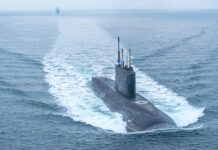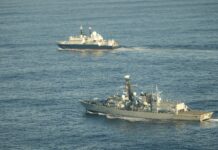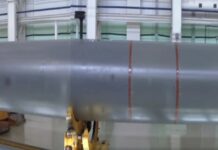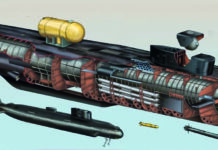According to various Russian news agencies and online forums, the Russian Kirov-class nuclear-powered guided-missile cruiser Admiral Nakhimov was scheduled to deploy to sea in late 2024, after an extensive service overhaul, and initiate sea trials. This intention was confirmed by the general director of United Shipbuilding Corporation, Andreĭ Puchkov, who made his announcement on the sidelines of the International Maritime Defence Show ‘Flot-2024’, which took place in Kronstadt from 19 to 23 June 2024.
While the announcement that a Russian warship might soon deploy to sea following a maintenance period by itself is nothing spectacular, the information does become significant when the bigger picture surrounding Admiral Nakhimov is taken into consideration. Laid down in May 1983, Admiral Nakhimov entered service in 1988. Having been withdrawn from active service in 1997 and docked at the Sevmash shipyard for repair and modernisation since 1999, in 2013 Sevmash and the Russian Ministry of Defence entered a contract envisioning that Admiral Nakhimov would return to the fleet in 2018. However, by March 2019 life support systems were still being repaired and updated and cable routes were being installed.
A long-heralded return
Given that senior personnel in the Russian Navy and naval shipbuilding industry have repeatedly announced the impending return to service of Admiral Nakhimov, this year’s announcement should be treated with some caution. In 2017, for example, Chief of the Russian Navy Admiral Vladimir Korolev (2016-2019) announced that Admiral Nakhimov would be transferred back to the fleet in 2020. Later, the head of the technical department of the Russian Navy, Rear Admiral Igor Zvarich, announced that the repair and modernisation of Admiral Nakhimov would be completed before 2021. All these deadlines have been missed.
The point worth debating, however, is less about the exact date Admiral Nakhimov will return to the fleet in the future and more about the enormous amoount of resources the Russian Navy has already invested into maintaining the vessel, particularly if the value the Kirov-class cruiser adds to the capabilities of the Russian fleet is taken into consideration.
Built during the 1980s, the original purpose of the Kirov-class combatants was, on the one hand, to serve as command ships for naval formations and, on the other, to destroy NATO naval formations, especially carrier strike groups. In order to achieve these tasks the Kirov-class cruisers were designed to carry 20 P-700 Granit (SS-N-19) long-range surface-to-surface missiles and to reach high speeds: their nuclear reactors provide the vessels with sufficient energy to reach speeds of more than 30 kts (55.6 km/h) despite having a displacement of 24, 500 tonnes. In light of their role as task force flagships, Kirov-class vessels also feature S-300FM (SA-N-20) long-range surface-to-air missiles and 10 533 mm torpedo tubes, either for torpedoes or anti-submarine missiles.

Following its modernisation, open-source reports indicate that Admiral Nakhimov’s new armament will consist of a universal vertical-launch system capable of launching P-800 Oniks (SS-N-26 ‘Strobile’) anti-ship missiles,missiles of the Kalibr family and scramjet-powered 3M22 Tsirkon (SS-N-33) hypersonic anti-ship cruise missiles. Apparently, the Russian leadership is confident that the modernisation of Admiral Nakhimov will pay off. Russian media and internet-based naval commentators are pushing the narrative of a tremendously powerful ‘battlecruiser’ and ‘Death Star’, while the general director of Sevmash, Mikhail Budnichenko – apparently supremely confident of the state-of-the-art technology of this 1980s-built but decades-long-modernised warship – claims that “After being transferred to the fleet, Admiral Nakhimov will serve for at least 30 years.”
The way in which the Russian Federation has invested in this cruiser raises questions about Russian naval strategy that go beyond the level of analysis of the individual warship. Firstly, from an operational point of view, it is highly doubtful that Admiral Nakhimov can ever assume the role of a potent task force-destroying platform bristling with guns that it was originally designed to carry out. Already by the time of the Cold War it can be debated whether a Kirov-class cruiser – despite its speed, air defences and the comparatively long range of its missiles – would have been able to get close enough to a NATO task force (such as a US carrier strike group or amphibious readiness group) to wreak havoc among the NATO warships in a hypothetical combat scenario. The major surface combatants of the Soviet Union would have enjoyed some degree of air cover provided by the sizeable Soviet naval aviation arm, which consisted of approximately 70,000 personnel in four fleet air forces operating more than a thousand aircraft complemented by four Kiev-class aircraft carriers and, if operational in time, two Kuznetsov-class carriers. Almost half a century later, however, with Russian air cover restricted to limited numbers of land-based fighters and Western advances in intelligence, surveillance and reconnaissance (ISR) technology and advanced high-precision weapons, the survivability of Russian capital warships in a high-intensity scenario appears very low.
Expensive capital assets
In addition to the issue of the effectiveness of these cruisers in a high-intensity conflict scenario comes the question of resource allocation and opportunity cost. As of the summer of 2023, information released by Russian media estimated the cost associated with repairing and modernising Admiral Nakhimov at RUB 200 billion (EUR 1.91 billion): a sum that may not even be final. In comparison, open-source estimates on the cost of a single Russian Karakurt-class corvette vary between RUB 5 billion and RUB 10 billion. Of course, the capabilities offered by a Kirov-class cruiser are greater than those of an individual 800-tonne corvette. Still, during a period when the US Navy is debating concepts to disperse the fleet for survivability and lethality and when the Russo-Ukrainian War has once again demonstrated the vulnerability of capital warships, making such exceptionally large investments on a single platform appear very questionable.
Admiral Nakhimov is not the only Soviet legacy unit for which Russia is justifying large investments. Its sister ship, the Kirov-class cruiser Pyotr Velikiy, was laid down in 1986 and – after a long break following the dissolution of the Soviet Union – has been in service for more than a quarter of a century. A year ago Russian media reported on plans to decommission Pyotr Velikiy, possibly once Admiral Nakhimov returned to active service. Almost immediately, however, these reports were denied by other Russian media sources and, as of July 2024, Pyotr Velikiy remains in service – as does the Kuznetsov-class aircraft carrier Admiral Kuznetsov: another vessel of limited operational value built during the 1980s that has been undergoing overhaul and modernisation since 2017. However, multiple fires during this work, along with reports in September 2024 that the carrier’s crew had been re-assigned to combat duties in Ukraine, suggest that Admiral Kuznetsov remains far from ever returning to service.
An obvious new paradigm
These investments into capital ships stand in contrast with the Russian Navy’s own experience in the Russo-Ukrainian War. Operations in the Black Sea have shown how Ukraine, using an asymmetrical ‘mosquito fleet’ approach, has forced the Russian Navy to withdraw from the northwestern Black Sea and has been able to cause significant destruction and damage to the Russian Black Sea Fleet. The Russian Navy has paid a high price but is also adapting, as shown by the identified need to upgrade the armaments of naval vessels, the establishment of drone-hunting helicopter squadrons and the adoption of new deceptive camouflage schemes. In March 2024 Admiral Aleksandr Moiseyev was appointed acting Chief of the Russian Navy: a posting that, according to Russian news sources, is closely linked with the expectation that Adm Moiseyev will have to solve the issues related to the naval war in the Black Sea and the state of the Russian fleet in general.
In light of major losses and the difficulty the Russian fleet has faced in trying to maintain sea control even against a much smaller opposing force, the Russians may also seriously have to think about refining their naval strategy – especially as they think about a potential confrontation with NATO’s superior naval forces. In this context Admiral Viktor Chirkov, formerly chief of the Russian Navy from 2012-2016, has stressed the importance of developing the navy, “taking into account today’s events” and the need “to be prepared, taking into account the requirements of combating naval drones”. Arguing along similar lines, former Russian Pacific Fleet commander Admiral Sergeĭ Avaki͡ant͡s has stated that it would be a grave mistake for the Russian Navy to try to “solve strategic problems by quantitative accumulation” and has instead demanded, “We need to proceed with quality and solving problems asymmetrically.”
Delusions of grandeur
During the 2010s various scholars and experts commented on the Russian Navy’s transition toward being a green water fleet despite Russian maritime doctrines and naval leaders clinging to unachievable blue-water ambitions. A decade later the Russian Navy is experiencing first-hand how its conventionally far superior fleet has suffered disproportionate damage from an opponent that has waged a successful asymmetric strategy. Given NATO’s great superiority in forces and its favourable geostrategic position, even more so after the accession of Sweden and Finland, Russia would be well advised to finally let go of unrealistic and extremely costly dreams, such as ‘developing the Russian Federation as a great sea power and strengthening its position among the leading sea powers of the world’ [a Russian national strategic objective] or ‘ensuring the capabilities of the shipbuilding complex of the Russian Federation for the construction of large-tonnage ships, including modern aircraft-carrying ships for the navy’ [a Russian national shipbuilding priority], as outlined in the 2022 Russian Maritime Doctrine. Even a quarter of the way into the 21st century these positions are backed by old-school officers such as Vice Admiral (ret) Vladimir Pepeli͡aev (former deputy chief of the Main Naval Staff) or Professor Captain Evgeniĭ Losev (Kuznetsov Naval Academy), who argue in favour of an ‘oceanic fleet’ and (re-)acquiring aircraft carriers as a ‘strategic and political instrument of Russia as an oceanic power’.
In contrast, cost-efficient asymmetric naval warfare and mosquito fleets are already creating greater headaches for Western naval planners than 50-year-old ex-Soviet major surface combatants ever could. The Russian Federation already possesses significant experience in operating autonomous vehicles, as the country ranks among the top players in deep-sea operations and research, but smaller unmanned surface vessels (USV) for coastal areas are also being developed and built by Russian institutions. Among others, the Sakhalin Bureau of Construction for Automated Equipment for Maritime Research, which is assigned to the Far Eastern Department of the Russian Academy of Sciences, has been developing USV technology for years. It is also documented that Russian experts and technicians are analysing weapon systems used by Ukraine in order to develop appropriate countermeasures. Developments such as the inauguration of the Federal Centre for Unmanned Aerial Vehicles in the ‘Rudnevo’ Industrial Park in November 2023 can also be interpreted in this context. Given that Russia itself has captured Ukrainian USVs, it must be assumed that the Russian military-industrial complex is benefitting from experiences gained through naval warfare and the exploitation of Ukrainian technology.
Adopting USVs
Produced by the KMZ holding in St Petersburg, the BBKN Oduvanchik (‘Dandelion’) is the first offensive USV in Russian service and, according to information released by Russian sources in December 2023, is already in use in the area of the ‘Special Military Operation’ in Ukraine. As of December 2023 and May 2024, there have been reports of attacks by Russian ‘kamikaze’ USVs. Thus, it is of little surprise that the future offensive use of USVs is already vividly debated as Russian experts debate naval warfare development. Reportedly these have concluded that combat scenarios for which USVs may prove particularly suitable include attacks on an opponent’s critical maritime infrastructure, swarm attacks on lightly armed targets at sea, mine warfare and anti-submarine warfare.
For now, despite the fact that Russia seems to be adopting some systems and tactics as lessons learned from the Russo-Ukrainian War, and also seems to have begun employing USVs, massive investments continue to pour into maintaining and modernising Cold War-era legacy units, such as Kirov-class cruisers and the carrier Admiral Kuznetsov, as the naval leadership clings to Russia’s self-perception of being a great sea power.
For a number of reasons, one should hope that there will never be a situation in which Admiral Nakhimov will be ordered to fire a shot in anger, not least because the big, mighty ‘Death Star’ might turn out to be more vulnerable than expected – just like the Star Wars original.
Dr Tobias Kollakowski is a researcher at German Institute for Defence and Strategic Studies in Hamburg.












